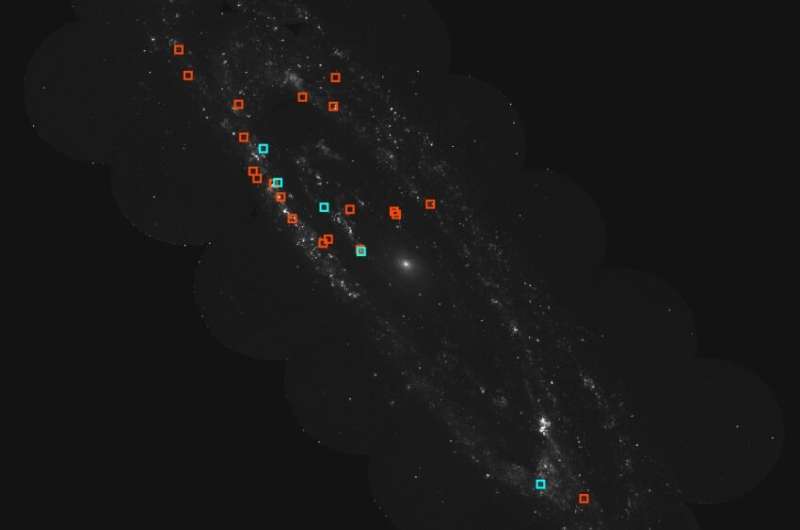February 2, 2023 report
This article has been reviewed according to Science X's editorial process and policies. Editors have highlighted the following attributes while ensuring the content's credibility:
fact-checked
preprint
trusted source
proofread
Astronomers identify 20 ultraviolet-emitting supernova remnants in the Andromeda Galaxy

Using the AstroSat satellite, astronomers from the University of Calgary, Canada, have identified 20 supernova remnants (SNRs) in the Andromeda Galaxy, which exhibit diffuse ultraviolet emission. The finding, presented in a research paper published January 25 on the arXiv preprint server, could help us better understand the origin and properties of ultraviolet emission in SNRs.
SNRs are diffuse, expanding structures resulting from a supernova explosion. They contain ejected material expanding from the explosion and other interstellar material that has been swept up by the passage of the shockwave from the exploded star.
Studies of supernova remnants are important for astronomers, as they play a key role in the evolution of galaxies, dispersing the heavy elements made in the supernova explosion and providing the energy needed for heating up the interstellar medium. SNRs are also believed to be responsible for the acceleration of galactic cosmic rays.
Although many extragalactic SNRs have been detected to date, the ones showcasing ultraviolet (UV) emission are difficult to find, mainly due to the strong interstellar extinction for our galaxy in the UV. What is noteworthy, despite the recent progress in UV-based SNR research, is that there does not yet exist a catalog of extragalactic UV-emitting SNRs.
That is why a team of astronomers led by Denis Leahy decided to conduct a search for UV-emitting SNRs in the nearby Andromeda Galaxy (also known as Messier 31, or M31), with the aim of generating the first catalog of such objects in another galaxy. For this purpose they employed AstroSat's Ultraviolet Imaging Telescope (UVIT).
"UV images of M31 were obtained by the Ultraviolet Imaging Telescope on the AstroSat satellite, and the list of SNRs was obtained from X-ray, optical and radio catalogs of SNRs in M31. We used the UVIT images to find SNRs with diffuse emission, omitting those too contaminated with stellar emission," the researchers wrote in the paper.
The team initially selected 177 SNRs in order to investigate whether or not they showcase diffuse ultraviolet emission. Out of the whole sample, 20 supernova remnants turned out to be UV emitters. The identified sources exhibit diffuse emission which is not associated with stars, although the strength of the diffuse emission varies.
The astronomers compared the band luminosities of these 20 SNRs to the band luminosities of seven previously known UV-emitting SNRs in the Milky Way, Large Magellanic Cloud (LMC) and Small Magellanic Cloud (SMC). In result, they found similar spectral shapes between the known SNRs and the SNRs in the Andromeda Galaxy. The finding suggests that the UV emission from the supernova remnants reported in the paper is dominated by line emission and that this emission is associated with the SNRs.
The authors of the study propose spectroscopic observations to confirm the line nature of the UV emission from the newly identified SNRs. However, they noted that it will be difficult to perform spectroscopy for the typically crowded regions in the Andromeda Galaxy where these SNRs are located.
More information: Denis Leahy et al, Discovery of 20 UV Emitting SNRs in M31 with UVIT, arXiv (2023). DOI: 10.48550/arxiv.2301.10381
Journal information: arXiv
© 2023 Science X Network





















